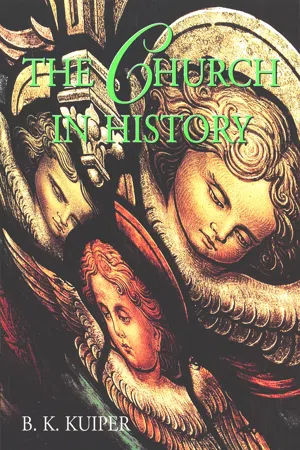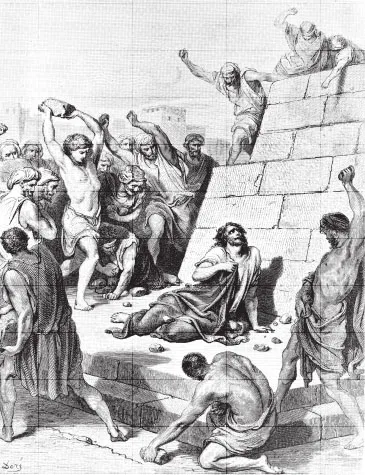![]()
THE NEW TESTAMENT CHURCH IS BORN
THE CHURCH IS TEMPERED
THE CHURCH GROWS INWARDLY
THE CHURCH IS VICTORIOUS
THE CHURCH CONSOLIDATES
THE CHURCH DETERIORATES
THE CHURCH SURVIVES AND GROWS AGAIN
![]()
CHAPTER 1
The New Testament Church Is Born
1. The Background of the Church
2. The Nature of the Church
3. The Physical Preparation for the Church
4. The Spiritual Preparation for the Church
5. The Expansion of the Church
6. The Character of the Church
1. The Background of the Church • Those who know the Old Testament story, the promise of the Messiah, the account of the life of Jesus, and the records of the acts of the apostles have had the finest possible introduction to the history of the Christian Church.
Originally God’s revelation was to all men. Only with Abraham, the first Hebrew, did He limit the scope of His promised redemption to the Old Testament people, and even then He assured this father of all faithful that in him all nations of the earth would be blessed. When the New Testament Church was founded, this promise was fulfilled (Galatians 3:8) by the extension of the Gospel to the Gentiles. Now, as at the beginning, all men would come under the preaching of the true religion.
The Hebrew people were the recipients of the Old Testament Truth, and to them Jesus came as the great final revelation of God (Hebrews 1:1-2). But they rejected their own kinsman as the Messiah. Following their rejection of Him, the Gospel was sent by direction of God to the Gentiles.
Our Christian faith, therefore, has its ancestry in the Hebrew religion. Jesus is the Messiah who is the fulfillment of the promises made to the Old Testament people. Time and again this relation is brought to mind by Matthew. Often when recording some incident in the life of Jesus, he says, “That it might be fulfilled which was spoken through the prophets.”
2. The Nature of the Church • When through His preaching, His atoning death, and His resurrection Jesus transformed the Old Testament national “Church” to the Church of the New Testament, He distinctly indicated the spiritual nature of this new institution. He did not arrange for an organization; He taught the principles upon which it should be built. He did not tell His disciples what the mechanical structure of the Church was to be; He sent them out to preach a salvation by faith in His name. Even when He warned about the opposition which they were to experience, He talked not about Roman emperors, but about the “gates of hell.”
When He was ready to leave this earth, Jesus promised the Spirit of Truth who would lead the disciples into all truth. Jesus stated that the coming of this Spirit was to be the prearranged sign that His followers should now go out from Jerusalem to the “uttermost parts of the earth.” All of these teachings are evidences of the fact that this new Church was to be a spiritual entity—one founded and directed by the Holy Ghost.
3. The Physical Preparation for the Church • Scripture says, “When the fulness of the time came, God sent forth his Son.” (Galatians 4:4). Such a statement is a clear indication that the world was prepared by God for the arrival of Jesus to do His redeeming work. In what way was it prepared? What were the conditions in the world when the New Testament Church began and when it first spread out from Jerusalem?
Rome ruled the “world.” (See map page 26.) That this fact was of significance to the coming of Christ is evident from Luke’s frequent references to the historical events of the Empire. He makes such statements as these: “There went out a decree from Caesar Augustus” and “In the fifteenth year of the reign of Tiberius Caesar.”
This great Empire prepared the physical scene for the spread of the Gospel. It gave peace in place of constant tribal warfare; it built a great network of roads and bridges that made travel possible all over the then-known world; it cleared the sea of pirates so that trade by sea and travel by ship became common practice; it protected its citizens from robbers and rioting. All of these conditions favored the easy movement of the messengers of Christ so that along the many roads which Rome had set up for her military purposes the Gospel of peace went out to the world.
4. The Spiritual Preparation for the Church • Not only did these physical conditions help the cause of the new missionaries, but the spiritual and intellectual climate was also readied for their work. Greece had spread her culture throughout the Near East and had “conquered” Rome with her civilization.
The Greek language had become the world language, one that would enable Paul to communicate with all his hearers in that part of the Roman Empire where he did most of his work. When Paul quoted the Old Testament to the Jews whom he met on his journeys, his quotations were from the Septuagint, a Greek version of the Old Testament made as early as two hundred years before Christ.
Greek philosophy had made many people doubt their gods whose strange activities now began to fade into myth and legend. The Roman gods came into disrepute, and many officials of the Empire continued to encourage religion only because such belief served to curtail revolt among the common people. The Roman state religion was clearly a political affair that offered no peace of mind to a disturbed soul. All this left a moral vacuum that boded no good for the world.
Under such conditions the Gospel came with its promise of peace, pardon from sin, rest for the heavy laden. Here was assurance, forgiveness, life, and salvation in Christ. This was the message that struck home, and the fullness of time made the rapid spread of this Word possible.
5. The Expansion of the Church • Many factors caused the Church to be extended. Direct revelation to Peter indicated that Gentiles also were to be included in the Church. The stoning of Stephen and the persecutions by Saul and others scattered the early Christians. Jews of the Dispersion, who had witnessed the events of Pentecost, carried the message of salvation when they returned to their homes.
Official missionaries, such as Paul, brought the Gospel to many pagan communities. Unofficial missionaries, the early converts, were themselves enthusiastic witnesses.
6. The Character of the Church • In the beginning the Church of Jerusalem was known for its spiritual beauty. The members were united by a spirit of love. This was shown in their sharing of material goods and their concern for the welfare of fellow members. They “were of one heart and of one soul.”
Courtesy Israel Office of Information
Remains of an Ancient Synagogue at Kfar Nachum (Capernaum)
Courtesy Israel Office of Information
A General View of Nazareth
The young Church was also marred by corruption and dissension. Selfish interest became a stumbling block. Factions, lawsuits, abuses of the Lord’s Supper, and other problems faced the Apostolic Church. The Jewish and Gentile Christians often found it very difficult to extend the hand of Christian brotherhood.
In spite of human shortcomings, the Church is the body of Jesus Christ. For it God prepared the world; for it Christ gave Himself; for it the apostles labored and suffered.
Now, with the blessing of the Holy Spirit, the stone cut from the mountain (Daniel 2:35) was about to fill the earth.
1.What is the Church? What is its work? Who is its head?
2.What do the verses from Galatians 3:8–14 indicate about the relation of the Old Testament Hebrew people to the New Testament believers?
3.What does the phrase “the fulness of the time” mean with reference to Jesus’ coming to earth? (Galations 4:4)
4.What work did Jesus do to found His Church?
5.What work did the Holy Spirit do for the early Church?
6.Why would Pilate write the placard for the cross of Jesus in Hebrew, Greek, and Latin?
7.How did Greek culture affect the spread of the Gospel by the early Church?
8.Why was it difficult for the Jews to understand that they must go to the Gentiles? How were they convinced that they should do so?
9.Is the Church spiritual or physical? Why?
10.What was the function of the miracles which were performed in the early Christian Church?
11.What was the culture of Greece?
12.Philip went to Samaria and founded a church; he also preached to an Ethiopian. Would he have done this before the new message of Christ had come to the Jews?
![]()
CHAPTER 2
The Church Is Tempered, 33-313
1. The Heroic Age of the Church
2. The Apostolic Church Is Persecuted
3. Nero, the First Emperor to Persecute Christians
4. Ignatius, Justin, and Polycarp
5. Persecution Is Continued Under Marcus Aurelius
6. A Lull in the Storm
7. Efforts Are Made to Destroy the Church
8. Galerius Calls a Halt
1. The Heroic Age of the Church • Christ had forewarned His disciples: “They have persecuted me, they will also persecute you.”
Throughout the first three hundred years of its existence the Church was tempered in the fires of persecution. This period has been called the Heroic Age of the Church.
2. The Apostolic Church Is Persecuted • Many leaders and members of the newly formed Church suffered for their Christian faith. This persecution began already in the history recorded for us in the Bible. Peter and John were imprisoned and persecuted on more than one occasion. Both Stephen and James had died a martyr’s death.
Religious News Service Photo
St. Stephen Being Stoned
After an Engraving by Gustave Doré
At one time when Paul was in Corinth, he was dragged by a Jewish mob into the court of the Roman governor Gallio. This governor would have nothing to do with the case and brusquely told the Jews to run along. When the Jews continued to press their charges against Paul, the governor had attendants drive them out of the courthouse.
The initial sufferings were inflicted upon the followers of Christ by the Jews, but in course of time, the attitude of the Roman government toward the Christians underwent a change.
3. Nero, the First Emperor to Persecute Christians • In the year 64 during the reign of Emperor Nero, fire broke out...





